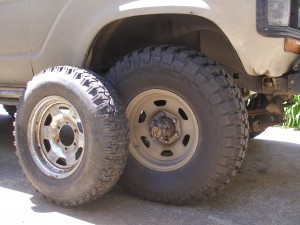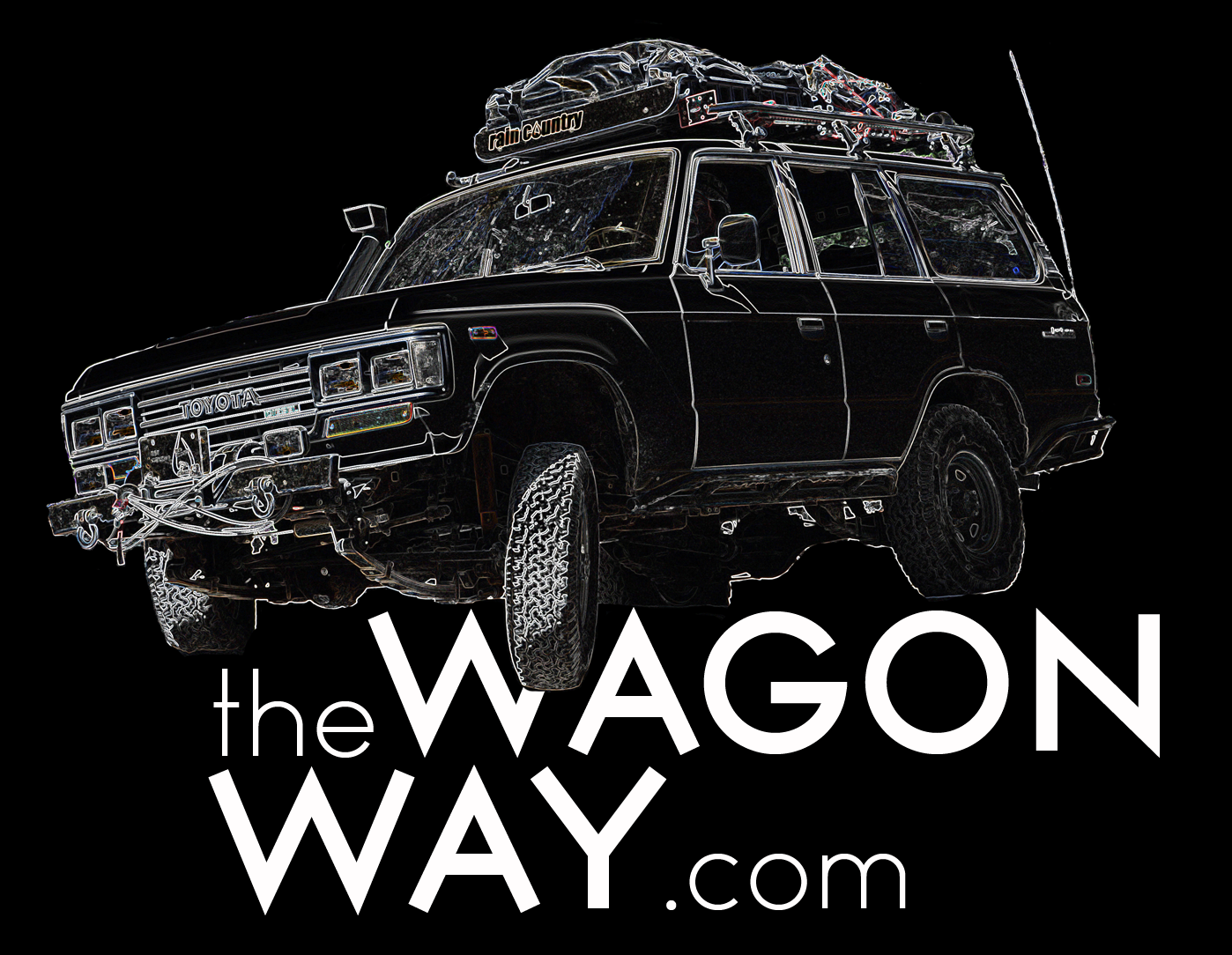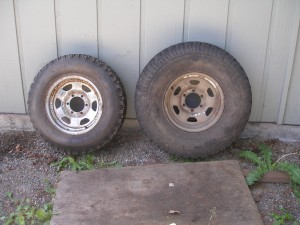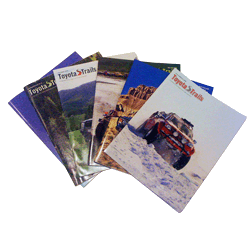By Tony K
 When our rigs are not performing up to par rarely do we look at the tires as the root cause. If you really want to see a drastic improvement in the performance of your rig throw a set of stock tires back on it and see what happens, you will be shocked.
When our rigs are not performing up to par rarely do we look at the tires as the root cause. If you really want to see a drastic improvement in the performance of your rig throw a set of stock tires back on it and see what happens, you will be shocked.
Tires do a lot of things all at the same time, they support the rig, provide the connection to the ground from your engine, even provide some of the suspension by absorbing lots of small bumps and vibrations.
And there is much more to tires than the numbers on the sides. Just what tires you use can improve or detract from that rig you love to drive. And you may notice that I don’t bring up the width of your tires, this write up is meant to address only how taller tires can affect your rig. Width is more of a steering and clearance issue.
-A Package Deal-
Tires are part of a package that makes our rigs run. They are the final part of the equation. They also seem to be the thing we mess with the most.
The engine provides the power supplied to the tranny which lets you change the output revolutions, transfer case reduces this or leaves it alone and the differential splits the rotations to both rear wheels as it reduces the spinning of the drivetrain. Hopefully, you now realize how this all operates as a package. Changing one thing will affect all the other parts in some way.
How many times does a tire rotate in a mile?
While you may not need to know the exact numbers, you should keep this in mind. Taller tires take less rotations to go the same distance as a shorter tire. And this may explain why and how your drivetrain reacts to the tires you have installed. Taller tires have been called a “rubber overdrive” for years. They are the equilvalent, if tall enough, of putting highway gears in your differentials, which may not be a good thing on a rig meant for the trail. But remember that the reverse is also true, shorter tires do the same thing as lower gears in the axle. Creating a “rubber underdrive” so to speak.
You could use a tape measure and do the math but there is an easier way. Tirerack.com is a great place to buy tires and it is also a great place to get the specs on a chosen tire including the “revolutions per mile”… This is an fixed number with the exception of some minor differences brought on by wear, tires will spin more in a mile as they wear. And even with weight distorting them it still takes the same revolutions per mile.
Some sample amounts of rotation by common tire size, last three are BFGoodrich KM2’s and the first one is a generic 225 75R15. Other brands in the same size will show similar numbers and tire rack lists specs for all sizes of the tires they sell.
29 715
31 675
33 634
35 598
What makes these numbers important to consider is the fact that our rigs left the factory with only 29’s. And I don’t know anyone who is still running the short factory size tire. We have already changed things without much thought put into it.
-Stock Tires-
60 series wagons left the factory with pretty short tires, my 1982 canadian BJ 60 had H78-15 and my 1990 US FJ62 came with 225 75R15’s. Both of these sizes are only about 29 inches high. But when the weight of the rig is on them they are considerably shorter. You will find this is true with all tire sizes, they are commonly listed by diameter of the unloaded tire. That first pic should give you an idea how different a stock tire is compared to a 33. And don’t forget that little tire doesn’t have any weight on it which will take another inch or more from the height.
-Gears to Tire Height Relationship-
What does this all mean? It means that our wagons were designed with a given tire size and axle ratio to achieve the best possible performance from the engine and tranny set up. There are other variables but I think this reduces it to the most basic parameters. If I was engineering the drivetrain of a wagon it is what I would consider to be of prime importance.
Increasing the tire size sets up a chain reaction in the system. It increases the leverage exerted by the tire against components, it reduces the rpm of the engine at a given speed by reducing the number of rotations per mile of the tire and increases ride height and ground clearance. Possibly moves the engine out of the power band that it likes to operate in and even creates errors in your speedometer and odometer.
When switching to a taller tire leverage plays an important role. Not so much on the highway but at crawling speeds and loads it plays a major role in the breakage of Birf’s and other components. Taller tires provide for a lot more leverage than short ones. Meaning that the risk of breakage increases with tire height. And just how much effect does this have on the diff gears, consider the fact that the Yukon gears I installed, have no warranty if you use larger than a 34 inch tire in a Toyota. This may have changed since I bought mine a couple of years ago but that was the warranty policy when I bought mine.
-On the Road-
A gear calculator is a good source for information and this link http://www.grimmjeeper.com/gears.html on the site goes to one that shows tons of info that will help you decide whether or not to change things on your rig. The following chart tells you what happens to highway speeds when ever you change gears or tires. The info came from the gear calculator. It assumes an engine rpm of 2500 and a 1 to 1 tranny ratio, numbers in the middle are the mph on the road.
Gears to Tire Size 29 31 33 35
3.70 58 62 66 70
4.11 52 56 60 63
4.56 47 51 54 57
4.88 44 47 50 53
What these numbers tell you is what you need to do to put your rig back to the performance it left the factory with and it also tells you what you may have done by only changing the tires (or just the gears). Where this is most noticeable is in a rig with an auto tranny ( The A440 used by Toyota is very sensitive to tire size) or one with a small underpowered motor such as the 3B in my diesel that I love regardless.
The best example I can give you for the validity of this is when I changed the diff ratio in my 62 from the stock 4.11’s to 4.88’s. I drove my 62 on 33’s for years with the stock gears and it was a bit of a pig. But after some careful thought and figuring, the 4.88’s brought it back to almost stock specs. The engine and tranny were once again operating as designed and the mileage acutally improved by about 5%.
While my solution came about with great results fairly quickly, the problem that started things (too tall of a tire for the gearing and tranny) follows the frog in boiling water analogy by occuring slowly over time, I didn’t notice the change for a long time. Very few of us have ever driven a rig with stock tires to compare the changes to. We just tend to change what we already have.
-Correcting Things-
What all this tells you is that with some careful planning and new gears it is possible to just about duplicate the original performance of your rig, no matter what tires you use. Or in some cases even improve it.
If the tire size change is minor you may not have to change anything. But more extreme changes in tire size require other changes, usually in the differentials. Not cheap but needed none the less. An overdrive may be a solution as well. An H55 installed in my diesel helped overcome a massive loss of highway mph without having to change out the low gears I already have in the diffs.
Higher powered rigs on the other hand can get away with bigger changes as the engine may overcome some of the loads imposed by the taller tires.
Can you operate outside the designed specs of our wagons, absolutely, but there are consequences and it just depends on what you are willing to put up with. So don’t just throw those 35’s on because they look cool, take the time to figure out what they will do to the performance of the rig, both on the highway and the rocks.


